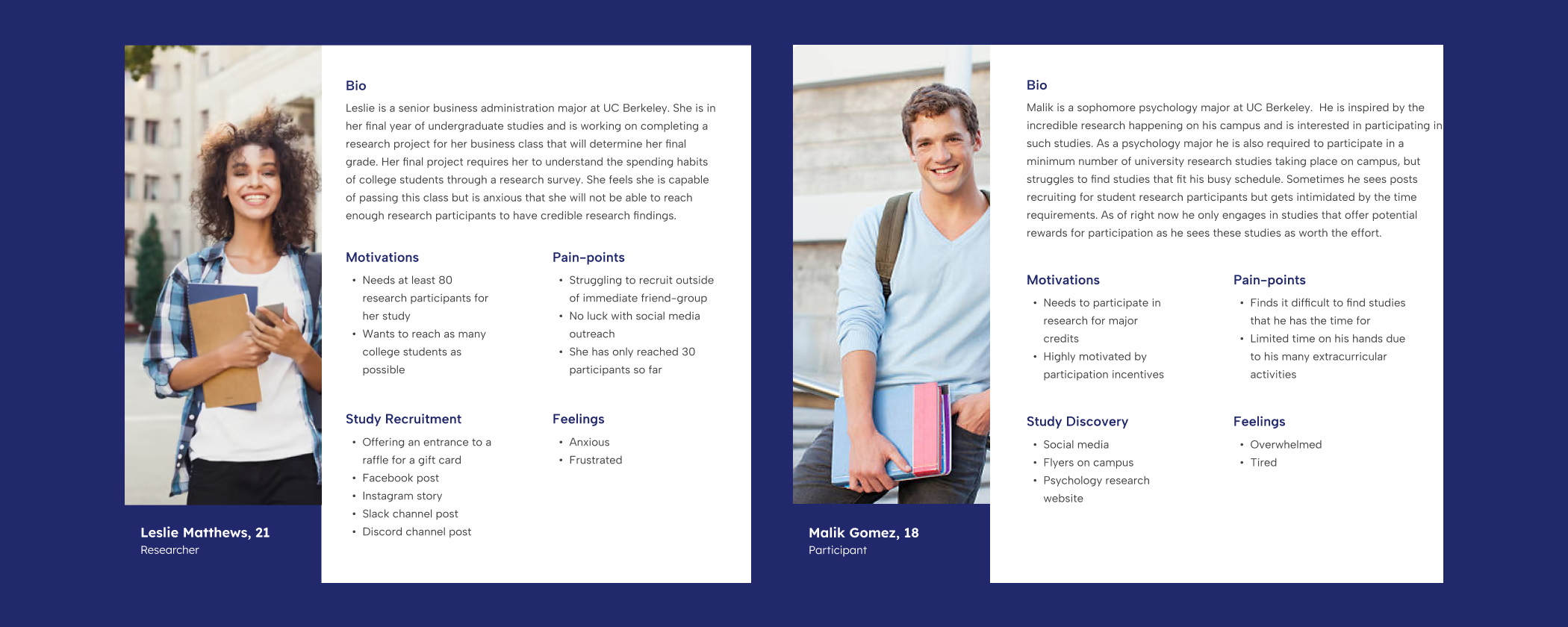
The Problem
Students often face challenges in recruiting participants for their research studies, while potential participants struggle to find opportunities that align with their schedules. This issue is critical because research plays a vital role in academic and scientific development on campuses. Additionally, students frequently need research participation credits to pass their courses so finding suitable research studies to participate in is a necessity.
Goals & Sucess Indicators
Goals and Objectives
Provide a centralized platform for research recruitment and participation that empowers users to:
Quickly and efficiently match studies to their lifestyle and availability.
Simplify the study recruitment process for researchers.
Enhance accessibility and visibility of research opportunities.
Research
Success Indicators
Increased user confidence in the ability to recruit study participants
Research participants show preference to finding studies to partake in on StudySpotter
Increased participation rates in studies posted on the platform.
Reduced time spent on participation recruitment and scheduling by researchers.
Methods
In order to adequately understand the problem space I thought it was best to conduct both interviews and observational research. I hoped to understand both the researchers and the student participants through interview questions. After speaking to both user groups I wanted to get a better understanding of what research participant recruitment looked like and how that process currently happens on college campuses.
Part 1 - Survey
I interviewed 4 UC Berkeley students who have conducted research on their peers. I spent 5 minutes asking them questions about their methods and experience with carrying out these studies. Through my interviews, I realized that all of the students who have conducted research have also participated in some other form of student research on campus.
Part 2 - Observational Study
After listening to student researchers explain their methods of recruiting participants, I looked around to find evidence of these recruitment techniques on campus and on social media. My goals were to identify the information used to inform potential participants about the advertised research and to also understand the kinds of research projects that required student participation.
To gather these examples, I walked around campus, photographing research study recruitment flyers. For online recruitment strategies, I scoured social media platforms, class group chats, Slack channels, and message boards, collecting numerous examples of students promoting their studies for participants.
Insights
Research Questions
Participant Insigts
Participants rarely pay attention to online posts recruiting for surveys unless it is a close personal contact.
Participants are more likely to participate if there is an incentive, including class credit.
Participants like to know how long their participation will take, with most preferring short studies.
User Personas
Browsing Studies
Create Study Form
Who are the people recruiting for student research participants?
What recruiting techniques are successful, and what techniques are unsuccessful?
Why do students choose to participate in research?
How are student researchers currently recruiting student participants?
When do the roles of student participant and student researcher transition?
Where do researchers and student participants currently find each other?
Ideation
Brainstorming Soloutions:
Wireframes:
Visual Design Iterations:
Soloution
On the home page of Study Spotter, you can find the latest studies that have been posted. Each study is displayed with a brief snapshot that includes the study's title, the department it is being conducted for, the type of study, the location, the deadline for participation, the estimated time to complete the study, and the type of reward offered to participants upon completion. To find studies that match their preferences, users can use the search bar or the drop-down filters.
Selecting a Study & Study Dashboard
When a user clicks on a study, it expands to display additional information such as the study's description, the number of participants required, the eligibility criteria, and a more detailed explanation of the potential reward. In the expanded view, users can click on the "Begin Survey" button, which will take them to the link where the study is being conducted as indicated by the researcher.
Researchers and participants can also easily access studies they’ve created or participated in, along with key metrics such as completed study units on the study dashboard bage. This page also provides seamless navigation for saved studies, allowing participants to track and revisit potential options in one centralized place.
When students want to publicize their research studies and attract participants, they simply enter their details into the "Create Study" form. This form captures key information, allowing participants to search and filter studies that align with their schedules and interests. Once researchers click "Publish Study," their study is posted on StudySpotter for all to see. The page remains editable, enabling users to update details or close their studies as needed.
Researcher Insights
Researchers do have minimum participant requirements.
Researchers usually recruit within their online social networks.
Researchers find that more students participate when there is a chance for a reward.
Researchers often struggle to recruit enough participants for their surveys.
Researchers use many types of data collection software.
Wrap-Up & Takeaways
If I had more time I would try to design an option that scanned survey websites and AI generated all of the information so researchers would only have to enter a link.
What I Learned
A valuable lesson I learned during my brainstorming and design process is that a simple solution is often the best one. I noticed that I have a tendency to overcomplicate things by accounting for all possible user scenarios, which can result in a convoluted user journey. However, when I refocused on my target personas, I was able to create a user flow that was straightforward and effectively addressed the initial problem question. This was challenging at first, but ultimately proved to be worth it.
Another important realization I had was that I shouldn't try to solve every issue in the problem space with my design. I found myself becoming overwhelmed by the research insights I had gathered and started addressing problems that were not directly related to my original "How might we?" question.
What I Would Do Next








